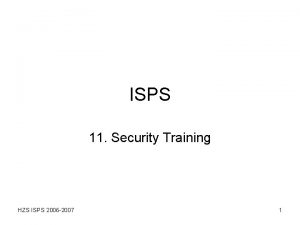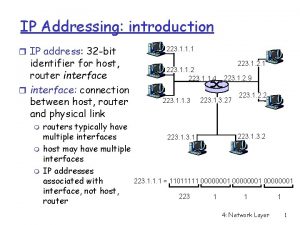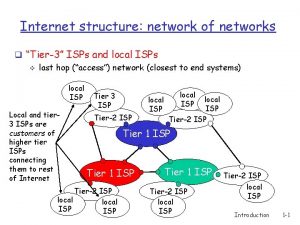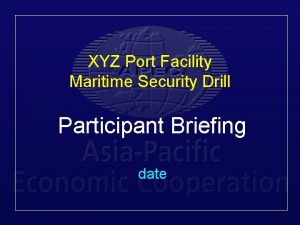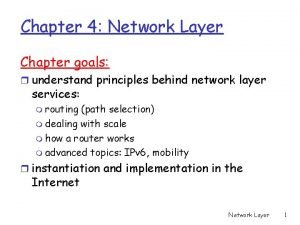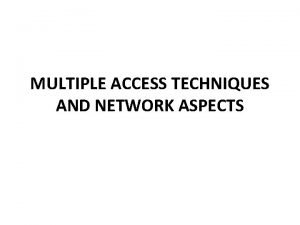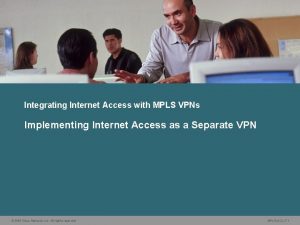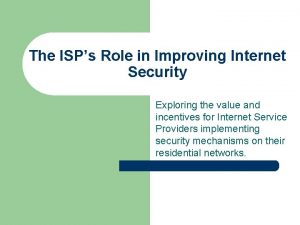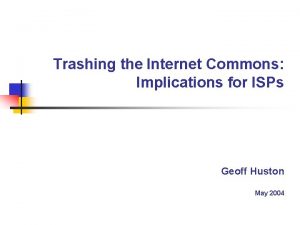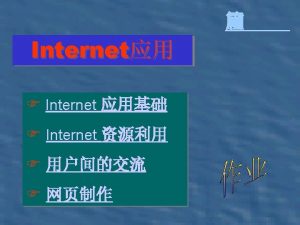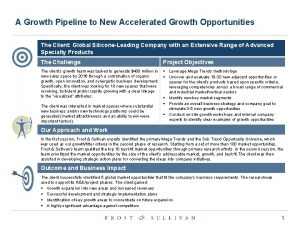Opportunities for ISPs q Internet access market growth




































- Slides: 36
















Opportunities for ISPs q Internet access market growth – Penetration is still low – Large areas are still underserved – New applications, corporate and personal, require more and more bandwidth q Standardization is slow, but “All over IP” reigns q Economy grows => demand grows q “Entry costs” became lower for ISPs 16

Restraining factors q Wireless Access needs spectrum, which is not uniformly allocated all over the world – Wi. MAX Forum (and vendors) have been focused on 3. 5 GHz band for fixed and 2. 5 GHz mobile Wi. MAX profiles – Very often 3. 5 GHz is densely occupied by incumbent carriers, VSAT links, etc. – Cost of 2. 3 -2. 7 GHz spectrum is too high – most mobile carriers already there q Performance is usually far less than in adverts q “Cost per new subscriber” restricts massive rollout of “public” access services 17

ISP Challenges q Different markets = different strategies q “Broadband for everyone”: – Low “entry cost” for end-user – Quick, plug-n-play installation – Low monthly fees for low-speed (<1 Mbps) – Dense coverage required as most of the users are willing to use indoor/window antenna or even portable device 18

WISP Challenges q “Broadband for business”: – High speed both in uplink and downlink • >2 Mbps is typical, without oversubscription • Site-to-Site VPN is primary service, not just internet access – – Low delay for voice and videoconferencing Quality service for multiple users (Qo. S everywhere) High reliability, link redundancy Coverage can be sparse but range should be long enough – most of the users are fixed and can use rooftop antenna 19

WISP Challenges q Applications that require specific features: – Video Surveillance • 2 Mbps per camera, mostly only upstream – Rapid deployment communication systems • Topology-independent network required – Public Safety & Corporate Security applications • All the above, plus extra network robustness and security 20

Wi. MAX, pre-Wi. MAX, 3 G, MESH what’s the difference? q Wi. MAX – a global standard for interoperability between wireless access devices, based on IEEE 802. 16 d-2004 (fixed) and 802. 16 e-2005 (mobile) standard q Current status: – Frequency bands available: 2. 3 -2. 5 GHz, 3. 4 -3. 6 GHz, 5 GHz (not certified yet) – Note: NO REAL INTEROPERABILITY yet 21

Wi. MAX technology highlights q OFDM 256 (or higher), adaptive coding/modulation (BPSK to QAM 64) q OFDMA and sub-channelization help to “pull up” uplink coverage (while usually offering less bandwidth per single CPE) q Flexible spectrum usage – channel sizes from 1. 75 to 10 MHz, with high tolerance to self-interference q Fast scheduling to optimize downlink q MIMO (and “smart antenna”) support in the standard (but not widely available yet) q Mutual BS-CPE authentication with X. 509 public key q Real throughput (capacity): – Downstream: 5. . 25 Mbps per BS sector – Upstream: 1. . 3 Mbps (mobile), 2. . 10 Mbps (fixed) 22

Wi. MAX technology restrictions q Typical (best case) RTT (station-to-server) is ~80 ms, worst case delay is >100 ms in a normal operating conditions – still better than in “traditional” GSM/CDMA mobile networks – Too big for Vo. IP within site-to-site VPN even if both users are in the same network – Fractional E 1 (or other TDM) services over Wi. MAX will require extra dejitter buffer/echo cancellation circuits (typ. jitter is >20 ms) 23

Wi. MAX technology restrictions q Coverage radius is much less than expected: – 1. . 2 km - indoor/NLOS subscribers at 2. 5 GHz band –typical mobile case – 7. . 20 km – fixed, external high-gain antenna CPE in LOS conditions q Subscriber density issues – high-density coverage is required for mobile/indoor users, high capacity is needed for fixed/business users 24

Proprietary Wireless Access technologies q Wide choice of spectrum – 900 MHz, 2. 3, 2. 4, 2. 5 -2. 7, 3. 5, 4. 9, 5. 1 -6. 4 GHz – 5/10/20 MHz typical channel sizes q OFDM 64 modulation, often auto BPSK to QAM 64 q Some pre-Wi. MAX systems support Qo. S in wireless q BS sector capacity is sometimes MORE than Wi. MAX – 15. . 30 Mbps LOS, 2. . 7 Mbps NLOS, depending on freq band q Coverage area is less, but still can be compared to fixed Wi. MAX case q Mobility is supported in MESH systems, while traditional MESH performance is much less than mobile Wi. MAX could offer q No interoperability between different vendors q Lower BS price 25

The Choice q Fixed and mobile Wi. MAX are DIFFERENT in technologies used, BS coverage and capacity and, therefore, in rollout costs q Wi. MAX idea is “Personal Broadband” – hundreds of home-users per BS q Some myths are still exist – that (pre-Wi. MAX) system could be used for IP-TV broadcast or even large-scale Video-on-Demand delivery q ISP should consider offering services to businesses and home-users as TWO different tasks, as the whole network infrastructure shall be different 26

Infi. Net Wireless Strategy q Single platform approach – Sky. MAN NG – – Pre-Wi. MAX multipoint Fixed Wi. MAX Mobile/nomadic MESH Backhaul q Qo. S support q Topology-independent network q Modular, All-IP based design q Rich networking feature set 27

Infi. MAX High-speed fixed access system (802. 16 d-2004 -compliant) q 5 GHz freq band is supported – enables smooth transition to Wi. MAX for existing license holders without replacing the whole 5 GHz passive equipment and applying for a new 2. 5/3. 5 GHz license q Channel sizes of 5 and 7 MHz allow better frequency reuse while offering high capacity (real throughput of 1215 Mbps per sector) q High output power (+43 d. Bm typical EIRP) q Ideal quality of Voice transmission over Wi. MAX – using proprietary extensions to overcome 80 ms delay issues q Built-in Router, VLAN Switch, Vo. IP and E 1 gateways q Modular design – no costly “BS Controllers” 28

Infi. MAN Topology-free fixed access system q Channel sizes of 5/10/20 Mhz across 900 MHz, 2. 3, 2. 4, 2. 5 -2. 7, 3. 5, 4. 9, 5. 1 -6. 4 GHz bands q Typical sector capacity of >20 Mbps (up to 34 Mbps) q High output power (+43 d. Bm typical EIRP) q 7 to 35 km typical coverage radius q Transparent Qo. S support at Layer 2 -Layer 3 -Layer 4 throughout Sky. MAN network, including Infi. MAX and 3 -rd party Qo. S tags q Vo. IP-aware. Can automatically recognize and serve as top-priority most of interactive and delay-critical applications q Each unit, even indoor CPE, has built-in Router and VLAN Switch, Vo. IP and E 1 gateways are offered as options q Dual- and single-radio modular design for BS and repeater units 29

Infi. LINK high-capacity aggregated backhaul q Channel sizes of 5/10/20 Mhz across 900 MHz, 2. 3, 2. 4, 2. 5 -2. 7, 3. 5, q q q q 4. 9, 5. 1 -6. 4 GHz bands Aggregated link throughput of 60 Mbps High output power (+27 d. Bm mean output) Up to 70 km range Transparent Qo. S support at Layer 2 -Layer 3 -Layer 4 throughout Sky. MAN network, including Infi. MAX and 3 -rd party Qo. S tags 10/100 Ethernet, 2 x. E 1/Ethernet and 4 x. E 1/Ethernet interface options Low delay and jitter (<8 ms) Dual- and single-radio modular design for BS and repeater units 30

Infi. SAFE Mobile and Nomadic MESH q q Topology-independent, self-organizing MESH network Available in 900 MHz, 2. 3, 2. 4, 2. 5 -2. 7, 3. 5, 4. 9, 5. 1 -6. 4 GHz versions Channel-size is automatically selected – 5/10/20 MHz Special applications including fixed and mobile video surveillance, Vo. IP and video conferencing q Seamless mobility and multi-frequency roaming q Transparent Qo. S support at Layer 2 -Layer 3 -Layer 4 throughout Sky. MAN network, including Infi. MAX and 3 -rd party Qo. S tags q Single-, dual- and quad-radio modular design for BS and repeater units eliminates extra delays and bandwidth losses at each MESH node 31

Sky. MAN NG: factors to consider üSpectrum availability at licensed/unlicensed bands üSubscriber density and coverage area size üDemand for bandwidth demand üBackbone capacity üMobility üServices to be offered =Overall Solution Cost 32

Sky. MAN NG Case 1: City-wide ISP network for home and So. Ho users Expected density: >100 users per BS Services offered: Internet access (oversubscribed), Vo. IP, low-speed VPN – all below 1 Mbps Solution: 1) Access network – Infi. MAX or Infi. MAN, depending on overall estimated BS/CPE qty; Typical mix of indoor/outdoor subscriber units: 1: 10 2) Backhaul – Infi. LINK redundant links with integrated antennas Case 2: ISP network for VPN and high-speed internet access, provisioning for small ISPs Expected subscriber density: sparse, long distance to BS Expected capacity: 2. . 4 Mbps per user (per building) Additional Services: Corporate Vo. IP within the network, high-speed symmetrical VPN – all above 2 Mbps Solution: Access network – Infi. MAN, with repeaters. CPE unit – outdoor, with integrated antenna Backhaul – Infi. LINK redundant and aggregated links, fiber/metro Ethernet where possible, SDH if link capacity is still not enough 33

Sky. MAN NG Case 3: VPN connectivity in underserved area Expected density: <10 customer sites in total Distances: 10 to 50 km Services offered: Share central cite VSAT Internet uplink, corporate Vo. IP, high-speed VPN, video surveillance from remote sites (Vo. D from remote DVRs) Solution: Infi. MAN and Infi. LINK-based corporate wireless network, depending on topology, LOS conditions and overall capacity required CPE unit: high-power device with external high-gain antenna Case 4: Rapid deployment security and video surveillance for a closed area (large construction site, oil field, etc. ) Expected mobile unit density: medium-sparse Coverage area: small (<10 km) Expected capacity: 2. . 4 Mbps per mobile unit, 2 Mbps per fixed hi-res PTZ video camera Additional Services: Vo. IP between cars, 3 rd-party devices support (in-car laptop/phone, Wi. Fi tracking sensors) Solution: MESH network – Infi. SAFE, with fixed and mobile repeaters Mobile unit: dual-radio Infi. SAFE device to ensure quick relaying and seamless hand-off No dedicated backhaul – MESH network should be planned with some extra capacity 34

Conclusion q Wi. MAX or other wireless technologies do require careful RF, capacity and cost structure planning q Spectrum costs and applicability should be considered – for example, 5 GHz Wi. MAX is not intended to be “mobile” 35

Вопросы? Спасибо за внимание! www. infinet. ru www. infinetwireless. com
 Isps security level 1 2/3
Isps security level 1 2/3 Isps-r-us
Isps-r-us Tier 3 isp
Tier 3 isp Isps kod güvenlik seviyeleri
Isps kod güvenlik seviyeleri Isps drill scenario
Isps drill scenario Isps drills
Isps drills Goals of network layer
Goals of network layer Functional requirements of isps code
Functional requirements of isps code Leader challenger follower nicher
Leader challenger follower nicher Segmentation, targeting, positioning
Segmentation, targeting, positioning Pvgo
Pvgo Plant growth definition
Plant growth definition Eudicot
Eudicot Growthchain
Growthchain Primary growth and secondary growth in plants
Primary growth and secondary growth in plants Vascular ray
Vascular ray Geometric vs exponential growth
Geometric vs exponential growth Neoclassical growth theory vs. endogenous growth theory
Neoclassical growth theory vs. endogenous growth theory Difference between organic and inorganic growth
Difference between organic and inorganic growth Product market screening criteria should
Product market screening criteria should Identify market opportunities
Identify market opportunities Terminal access controller access control system plus
Terminal access controller access control system plus Terminal access controller access-control system
Terminal access controller access-control system Mpls vpn internet access
Mpls vpn internet access Internet access techniques
Internet access techniques Presentation survey questions
Presentation survey questions Mpls internet access
Mpls internet access Internet access solutions ltd
Internet access solutions ltd Internet or internet
Internet or internet Gem board psx
Gem board psx Samsung bcg matrix
Samsung bcg matrix Forex market growth
Forex market growth Iso 22301 utbildning
Iso 22301 utbildning Typiska novell drag
Typiska novell drag Nationell inriktning för artificiell intelligens
Nationell inriktning för artificiell intelligens Ekologiskt fotavtryck
Ekologiskt fotavtryck Shingelfrisyren
Shingelfrisyren
